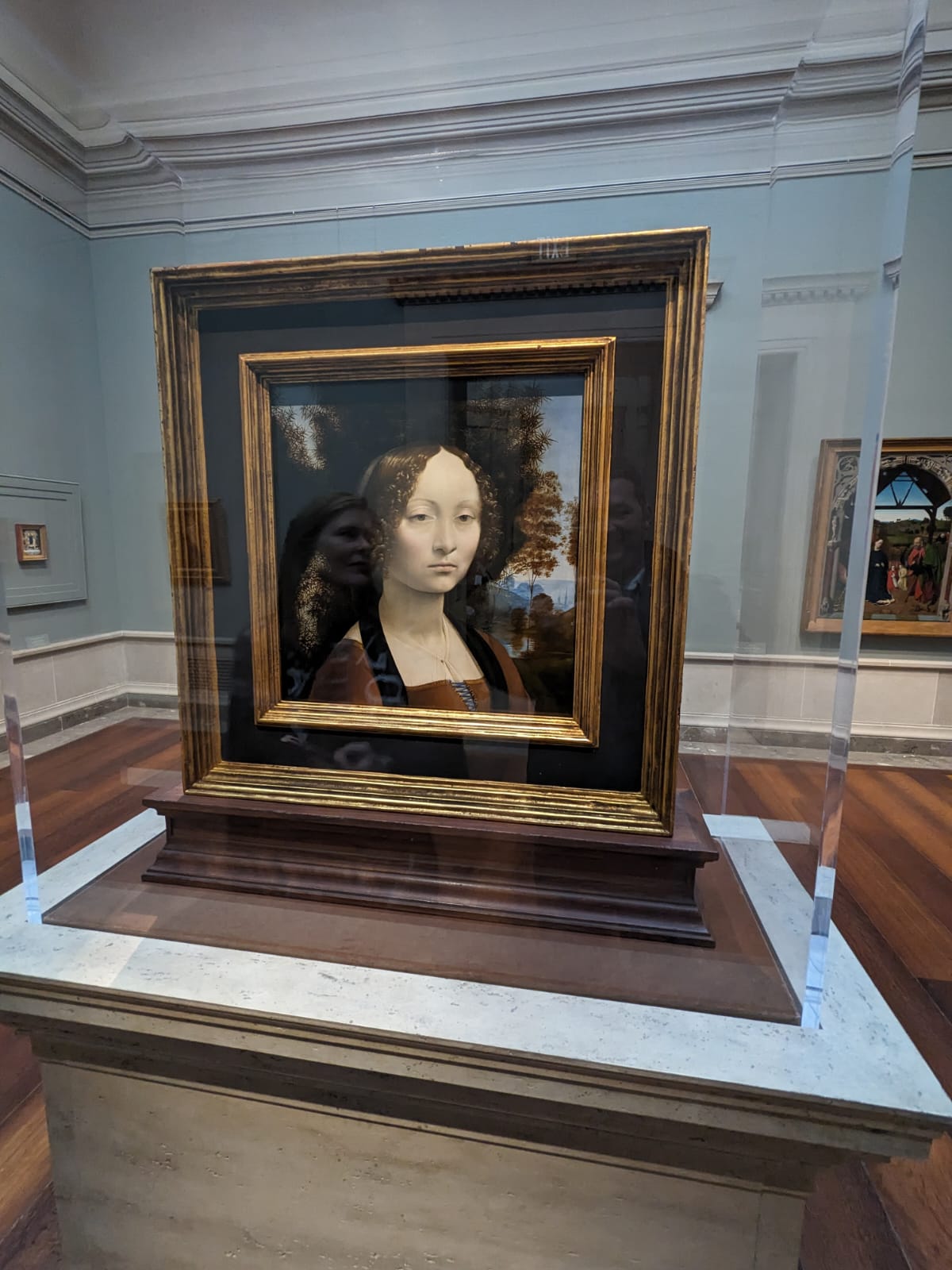Venturing into the realms of artistic brilliance and historical enigma, the exploration of Leonardo da Vinci’s ‘Ginevra de’ Benci’ unfolds as a captivating odyssey. This journey, marked by a keen appreciation for the intricacies of da Vinci’s craft, transcends the conventional boundaries of art analysis. Our endeavor is to unfurl the layers of intricacy cloaking this Renaissance masterpiece, navigating through the rivulets of history, the strokes of artistic genius, and the nuanced symbolism interwoven within the canvas. By immersing ourselves in the political and cultural currents that shaped Florence, scrutinizing da Vinci’s unparalleled technique, and decoding the cryptic language of symbolism adorning the canvas, we aspire to illuminate the perennial allure of ‘Ginevra de’ Benci’ and pay homage to the genius that breathed life into this timeless creation.
Immersing ourselves in the captivating allure of Leonardo da Vinci’s ‘Ginevra de’ Benci,’ we embark on a nuanced exploration that transcends the confines of conventional understanding, peeling back the layers to reveal the profound essence concealed within this Renaissance gem.
‘Ginevra de’ Benci’ Historical Context
The intricate tapestry of Renaissance Florence serves as the atmospheric canvas against which the timeless portrait of ‘Ginevra de’ Benci’ finds its place in history. Imbued with political intrigue, cultural fervor, and a burgeoning humanist movement, this epoch provides a rich and dynamic backdrop that profoundly shapes the enigmatic narrative woven within da Vinci’s masterpiece.
The Medici influence, a dominant force in the political and cultural landscape of Florence, cast a long and influential shadow during this period. The Medici family’s patronage of the arts, their strategic alliances, and their ascendance to power not only defined the political climate but also nurtured an environment that cultivated artistic innovation and expression. It was within this crucible of Medici patronage that Leonardo da Vinci, with his unparalleled artistic vision, found both inspiration and support for his creative endeavors.
Simultaneously, the burgeoning humanist movement, marked by a revival of classical ideals and a deepening appreciation for human intellect and creativity, permeated the air of Renaissance Florence. Scholars, philosophers, and artists alike embraced the revival of classical learning, fostering a climate where intellectual pursuits flourished. This cultural reawakening not only influenced da Vinci’s artistic philosophy but also contributed to the broader intellectual atmosphere that shaped the portrait’s genesis.
The artistic renaissance, a period characterized by a rebirth of creativity and innovation, further illuminates the historical stage upon which ‘Ginevra de’ Benci’ emerged. A collective yearning for artistic expression, experimentation, and a revival of classical aesthetics set the tone for the creative endeavors of da Vinci and his contemporaries. The artistic ferment of the period provided a fertile ground for the exploration of new techniques, innovative approaches, and a departure from conventional artistic norms.
In this rich historical context, da Vinci’s portrait of ‘Ginevra de’ Benci’ takes on a multifaceted significance. The interplay of political dynamics, cultural resurgence, and artistic fervor converges to illuminate the nuances of the subject’s identity, the symbolism embedded in the composition, and the artistic techniques that render the portrait a testament to the spirit of its time. The canvas becomes a reflection not only of Ginevra’s individuality but also of the broader currents that shaped Renaissance Florence, making ‘Ginevra de’ Benci’ a compelling and complex embodiment of an era in flux.
Subject Identity
Ginevra de’ Benci, an elusive figure veiled in the cloak of historical obscurity, becomes the focal point of our inquiry, inviting us to embark on a quest to unveil the intricacies of her identity. This enigmatic woman, immortalized by the stroke of Leonardo da Vinci’s brush, emerges as a mysterious protagonist, prompting us to delve into the annals of history in a relentless pursuit to decipher the layers of her existence.
The canvas of Ginevra’s life remains shrouded in historical ambiguity, presenting a challenge that beckons our meticulous exploration. To discern the woman behind the portrait, we navigate the labyrinth of historical records, immersing ourselves in the vestiges of the past, where fragments of her life are scattered like pieces of a complex puzzle waiting to be assembled.
A meticulous examination of historical records becomes the compass guiding our quest. Genealogical archives, familial connections, and historical documents become our sources of illumination, shedding light on the familial ties that wove the fabric of Ginevra’s life. Through these records, we trace the contours of her lineage, exploring the familial landscape that molded her identity and perhaps influenced the commissioning of this timeless portrait.
Societal standing emerges as a pivotal thread in unraveling Ginevra’s identity. As we traverse the historical landscape, we seek to understand the societal milieu in which Ginevra lived—a tapestry woven with societal norms, expectations, and the interplay of individuality within the broader context. Ginevra’s social standing becomes a lens through which we interpret the nuances of her character and the motivations that might have propelled the creation of this enduring masterpiece.
Insightful speculations, guided by a nuanced understanding of the cultural ethos of Renaissance Florence, become our companion in this journey. By immersing ourselves in the contextual nuances of Ginevra’s time, we endeavor to decipher the intricacies of her life, discerning the subtle motivations that prompted the commissioning of this iconic work of art.

In unraveling Ginevra de’ Benci’s identity, we traverse the intersection of history, art, and human experience. Through a tapestry of meticulous historical examination and insightful speculation, our endeavor is to breathe life into the enigmatic figure captured by da Vinci’s brush, illuminating not just a singular portrait but a profound narrative that transcends time and beckons us to connect with the essence of Ginevra’s existence.
Ginevra’s Artistic Techniques
Embarking on a journey to unravel the mysteries of Leonardo da Vinci’s artistry in ‘Ginevra de’ Benci,’ we turn our gaze to the strokes that transcend mere brushwork, breathing life into this masterpiece. In our quest to decipher da Vinci’s mastery, we venture into the realm of artistic techniques, where each stroke becomes a narrative thread weaving together a tapestry of unparalleled aesthetic brilliance.
Sfumato, a technique synonymous with da Vinci’s ingenuity, unveils itself as the ethereal veil that softens the edges of Ginevra’s countenance. Through the subtle gradation of tones, da Vinci blurs the lines between light and shadow, infusing the portrait with a sense of atmospheric depth that transcends the constraints of two-dimensional art. Sfumato becomes the subtle whisper that contours Ginevra’s features, casting a mysterious and alluring aura upon her visage.
Chiaroscuro, another facet of da Vinci’s artistic alchemy, emerges as the orchestration of light and shadow that dances upon the canvas. In the interplay of light and darkness, Ginevra’s presence is rendered with a nuanced three-dimensionality. The chiaroscuro technique, a symphony of contrasts, not only highlights the delicate features of the subject but also imbues the portrait with a captivating interplay of luminosity and shadow, unveiling the layers of Ginevra’s persona in a dance of illumination.
Beyond these techniques, da Vinci’s innovative approach to composition and his meticulous attention to detail become integral elements in the portrait’s transcendence. The juxtaposition of light against the juniper sprig, the delicate rendering of Ginevra’s intricately braided hair, and the ethereal quality of her gaze—all bear testament to the artist’s unwavering commitment to elevating every detail to a level of extraordinary finesse.
These artistic elements, far from being mere tools, emerge as the alchemical ingredients that transform ‘Ginevra de’ Benci’ into a symphony of aesthetic brilliance. Da Vinci’s mastery lies not only in his technical prowess but in his ability to transcend the ordinary, creating a portrait that goes beyond a mere representation of a subject and becomes a timeless embodiment of artistic genius. In scrutinizing these strokes, we come to appreciate not just the technical proficiency but the profound artistry that renders ‘Ginevra de’ Benci’ a masterpiece that continues to captivate and inspire across centuries.
Ginevra de’ Benci Symbolism and Iconography
Extending our journey beyond the visual allure of ‘Ginevra de’ Benci,’ we immerse ourselves in the symbolic language meticulously woven into each brushstroke by Leonardo da Vinci. In this exploration, every element, from the juniper sprig to the cryptic Latin inscription, unveils itself as a nuanced brushstroke of symbolism, creating a narrative that transcends temporal confines and invites the observer into a profound understanding of da Vinci’s artistic intent.
The juniper sprig, delicately cradled in Ginevra’s hand, emerges as a poignant emblem that encapsulates layers of meaning. Known for its association with fidelity and eternal love, the juniper becomes a living metaphor within the portrait, symbolizing not only the subject’s personal virtues but also the enduring nature of the sentiments encapsulated in the artwork. It is a visual poetry, a verdant emblem that speaks to the timeless themes of love and constancy.
The cryptic Latin inscription, inscribed on the juniper’s reverse, transforms into a lyrical code waiting to be deciphered. Da Vinci, known for his affinity for codes and cryptic messages, adds an enigmatic layer to the portrait. As we unravel the Latin script, we unravel a literary puzzle, a key to understanding the deeper layers of Ginevra’s persona and the artist’s intended narrative. The inscription becomes a linguistic brushstroke, enriching the visual tapestry with a layer of intellectual engagement.
The composition itself, with Ginevra’s ethereal gaze and the enigmatic smile, unfolds as a visual poem steeped in symbolism. Da Vinci’s deliberate choices in pose, expression, and the interplay of light and shadow transcend the realm of mere aesthetics. Ginevra becomes more than a subject; she becomes a symbol of beauty, mystery, and the ephemeral nature of human existence.
In this symbolic exploration, every stroke of da Vinci’s brush becomes a storyteller. The juniper sprig and Latin inscription are not isolated elements but integral components of a narrative woven with allegory and meaning. Each symbol becomes a conduit, inviting the observer to transcend the confines of the canvas and delve into the profound realm of da Vinci’s artistic intent. The symbolic language in ‘Ginevra de’ Benci’ is a testament to the artist’s ability to infuse his work with layers of significance, creating a timeless masterpiece that continues to resonate with audiences, beckoning them into the profound realms of symbolism and artistic contemplation
Conservation and Restoration
In contemplating the challenges of preservation, we reflect on the conservation and restoration efforts undertaken on this masterpiece. The restoration not only preserves the physical canvas but also impacts the lens through which we perceive ‘Ginevra de’ Benci’ in the contemporary context.
Legacy and Influence
The echoes of ‘Ginevra de’ Benci’ resonate beyond its canvas, influencing artists and shaping the trajectory of art history. Its enduring legacy is not confined to the past but reverberates through time, a testament to its impact on the evolution of artistic expression.
In conclusion, our exploration seeks not just to analyze but to immerse ourselves in the mystique of ‘Ginevra de’ Benci.’ Through a holistic understanding of historical context, subject identity, artistic techniques, symbolism, conservation, and legacy, we aspire to unearth the essence of da Vinci’s masterstroke—an essence that transcends mere artistic expression and beckons us to witness the timeless dance of genius and beauty.






